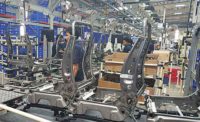The assembly line in Hall M13 at the ŠKODA plant in Mladá Boleslav is one of the Czech carmaker’s busiest. The best-selling ŠKODA Octavia is assembled here, as is the ŠKODA Enyaq iV electric SUV. Every minute of downtime on this line means losses in the form of unproduced cars.
In addition to quality, which is paramount for both the company and the customer, efficient use of capacity is crucial. That means minimizing stoppages, which in turn means minimizing the defects that cause stoppages. Defects can be prevented by enhanced preventive measures, which is expensive, or by more intensive maintenance when defects emerge, which is demanding in terms of personnel.
“Making use of modern technologies, digitalization and data collection to estimate when a given piece of equipment is on the verge of breaking down, and repairing it before the defect or stoppage occurs, is the optimal form of maintenance,” explains Marek Jancák, head of car production at ŠKODA.
This approach is called predictive maintenance, and it is one of the pillars of ŠKODA’s maintenance strategy. One of the first projects in this field is the deployment of predictive maintenance in Hall M13. Here, a machine vision technology called Magic Eye has been deployed to monitor the condition of the mobile girders from which cars are suspended as they proceed down the line. The technology is also being used to monitor the condition of so-called shins, which are the power and data interfaces for equipment on the line.
The overhead conveyor is the backbone of the plant. It handles almost 1,250 cars per day during a three-shift operation. There is no back-up equipment, so failure is not an option. The conveyor’s parts are exposed to relatively high forces, causing them to wear in a relatively short time. Given that the conveyor is several meters above the floor, it is difficult to access for inspection.
ŠKODA engineers developed the Magic Eye to continuously monitor the condition of the conveyor’s moving parts without the need for maintenance personnel to climb ladders and physically do the job.
Six cameras are mounted on the conveyor frame at strategic locations to monitor the condition of various conveyor elements. Rapid assessment of each trolley’s condition is carried out as the conveyor is running. Images collected by the camera are transmitted via WiFi to a central database, where they are analyzed by artificial intelligence algorithms. The software detects wear by comparing each new image of the trolley with previously collected images. If an anomaly is detected, the software sends an alert to maintenance personnel, who can fix the trolley before it can create unexpected downtime.
Machine Learning
Before the Magic Eye system could be put into practice, digital neural networks had to be taught to recognize defects. This required about three months of work and thousands of photos.
“We used photographs taken during a test run, but we also had to use an advanced mathematical modelling method to model some of the defects in a virtual environment,” says Libor Šída, who devised the Magic Eye system.
Modelling was necessary because some of the possible faults are rare but so severe that learning them from real-life practice would be a complication for the line. “For example, a cracked beam is a fault that basically can’t occur in practice,” explains Šída.
Neural networks are a fundamental element of artificial intelligence. These networks are a computational model that simulates the behavior of neurons in the brain. Artificial neurons transmit signals to each other in the network, and they process these signals using transfer functions. Neural networks are used in image or sound recognition, for example, for predicting how time series will develop.
The Magic Eye neural networks can now recognize 14 types of defects. “We can detect several classes for each defect. Think of these as the difference between a bolt that is either not tightened properly or is completely sheared off. In total, the system can detect about a hundred of these different conditions,” says Šída.
One special type of artificial neural network, known as an auto-encoder, also helps with the analysis. “This solution is used to detect defects that we haven’t encountered yet and therefore haven’t had the opportunity to simulate,” he adds. Such a defect could be a foreign object, like metal shavings, on the track.
Real-Time Analysis
Magic Eye now constantly monitors the condition of the assembly line equipment in Hall M13. During a single circuit of the line, the cameras collect around 450,000 images, which are sent via WiFi to a central database for immediate analysis.
If the system detects an irregularity, it alerts the maintenance operator, who then uses an app to determine whether it is genuinely an emerging defect or a false alarm. He can then plan the next steps accordingly: take immediate remedial action or, perhaps, schedule repair work during a scheduled downtime period.
“All the detected defects help us to continue learning and continuously improve the system,” says Filip Koliáš, head of central technical services at ŠKODA.
This is actually changing the perception of the maintenance profession itself. Maintenance employees are no longer just dexterous and skillful technicians and mechanics. They are also specialists who design and develop predictive maintenance methods. ŠKODA plans to deploy Magic Eye in other plants as well. Volkswagen Group, ŠKODA’s parent company, is also interested in the technology.









